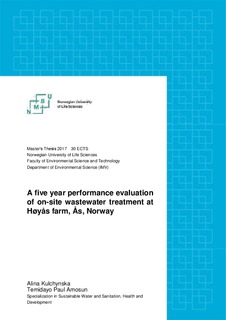| dc.contributor.advisor | Jenssen, Petter D. | |
| dc.contributor.advisor | Krogstad, Tore | |
| dc.contributor.advisor | Pandey, Manoj | |
| dc.contributor.author | Amosun, Temidayo Paul | |
| dc.contributor.author | Kulchynska, Alina | |
| dc.coverage.spatial | Norway, Ås | nb_NO |
| dc.date.accessioned | 2017-08-16T08:39:07Z | |
| dc.date.available | 2017-08-16T08:39:07Z | |
| dc.date.issued | 2017 | |
| dc.identifier.uri | http://hdl.handle.net/11250/2450862 | |
| dc.description.abstract | To prevent contamination of surface and groundwater sources, municipalities in Norway maintain strict regulations to control the discharge of treated wastewater. Municipalities with local codes set phosphorus (P) effluent discharge limit of 1 mg/l for wastewater treated with On-site waste wastewater treatment systems (OSWWTs) such as the constructed wetland/filter bed system in use at Høyås farm in Ås municipality. The system has been in operation for 5 years. The system component includes a septic tank and biofilter for pre-treatment. This is followed by two P filter units installed parallel to each. One unit is filled with P filter Filtralite-P (PFFP) while the other with P filter Filtramar (PFFM) also known as Shellsand. The last treatment units are two sand filter units installed parallel to each other to polish the effluent. One sand filter (SFFM) receives effluent from PFFM and the other sandfilter (SFFP) receives PFFP effluent.
The treatment system has been under study to monitor the performance since start of operation. This work evaluates the operation performance of the system for 5 years. This is done by taking Wastewater samples from effluent in each treatment components, analysing for P in form of total P (TP), and establishing time-series trend from data collected since start of operation.
Treatment performance parameters other than TP were evaluated by analysing for ortho-phosphate (Ortho-P), nitrogen (N) in form of total nitrogen (TN), ammonium ions (NH4+), nitrates (NO3-), conductivity, pH, as well as 5-day biochemical oxygen demand (BOD5). Time series report was made for each parameter to establish changes in effluent quality over time. After the 5th year, the Høyås system has a removal efficiency of 60% for TP, 60% for Ortho-P, >50% for TN, 92%-94% for NH4+, and >97% for BOD. Effluent pH is in range 7-8.
The final effluent using time series data has mean TP effluent concentration of 0.79mg/l and 1.08mg/l from SFFP and SFFM respectively and mean BOD concentration of 14.23mg/l and 7.23mg/l from SFFM and SFFP respectively. The treatment system meets the discharge limits of 1mg/l for P in the SFFP effluent. The SFFM effluent slightly exceeds the limit 1mg/l (mean final effluent still under 1mg/l). A time series forecast predicts the TP mean effluent to exceed limit within the next 5 months. The effluent BOD meets the 20mg/l for BOD set by the Ås municipality. | nb_NO |
| dc.language.iso | eng | nb_NO |
| dc.publisher | Norwegian University of Life Sciences, Ås | nb_NO |
| dc.rights | Navngivelse 4.0 Internasjonal | * |
| dc.rights.uri | http://creativecommons.org/licenses/by/4.0/deed.no | * |
| dc.subject | On-site wastewater treatment system | nb_NO |
| dc.subject | Filter bed systems | nb_NO |
| dc.subject | Constructed wetlands | nb_NO |
| dc.title | A five year performance evaluation of on-site wastewater treatment at Høyås farm, Ås, Norway | nb_NO |
| dc.type | Master thesis | nb_NO |
| dc.subject.nsi | Environmental Science and Technology | nb_NO |
| dc.source.pagenumber | 83 | nb_NO |
| dc.description.localcode | M-MINA | nb_NO |

